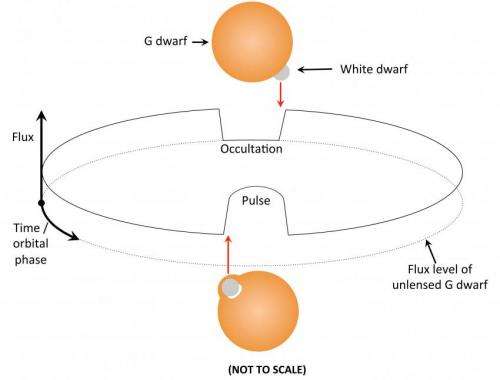April 18, 2014 report
Astronomers discover first self-lensing binary star system

(Phys.org) —A pair of astronomers at the University of Washington has discovered the first known instance of a self-lensing binary-star system. In their paper published in the journal Science, Ethan Kruse and Eric Agol describe how they happened across the previously theorized system while looking for undiscovered planets.
Scientists believe that nearly half of the stars in the night sky are multi-star systems, many of them binaries. Also, some binary star systems are unique in that their orbital path around each other lies in a plane with the planet Earth, which means from our perspective, they pass in front of one another on a periodic basis, causing an eclipse—generally, this results in dimming, which some might see as twinkling. In other instances, theory has suggested, the opposite should occur—instead of dimming, the eclipse should result in brightening—a phenomenon known as self-lensing—as the star in front magnifies light from the star behind it.
Self-lensing is based on Einstein's theory of relativity—light may not have mass, but it is still subject to gravity, it bends when passing stars for example. For that reasons, astronomers have been suggesting for years that if there existed a binary star system where one of the stars was similar to our own sun, but the other was a white dwarf—small but with a huge mass, and thus lots of gravity—than self-lensing should occur when the smaller star passed in front of the larger star. And that's just what Kruse and Agol have found.
The two were studying the star KOI 3278 because it had previously been found to dim on a periodic basis. Thinking it was doing so because of a planet passing in front of it, the researchers looked closer. Instead of a planet, the researchers discovered another star. As they orbited, the two stars took turns passing between us and their mate, every 88 days. When the sun-sized star was out front, the binary system dimed, as occurs with most binary star systems. But when the smaller star was out front, the two observed, instead of growing dimmer, the result was a very subtle brightening (a 0.1 percent increase) that lasted for five hours, confirming theories and stoking hopes that one day an observation will be made of a similar system made up of neutron stars or black holes.
More information: KOI-3278: A Self-Lensing Binary Star System, Science 18 April 2014: Vol. 344 no. 6181 pp. 275-277 DOI: 10.1126/science.1251999
ABSTRACT
Over 40% of Sun-like stars are bound in binary or multistar systems. Stellar remnants in edge-on binary systems can gravitationally magnify their companions, as predicted 40 years ago. By using data from the Kepler spacecraft, we report the detection of such a "self-lensing" system, in which a 5-hour pulse of 0.1% amplitude occurs every orbital period. The white dwarf stellar remnant and its Sun-like companion orbit one another every 88.18 days, a long period for a white dwarf–eclipsing binary. By modeling the pulse as gravitational magnification (microlensing) along with Kepler's laws and stellar models, we constrain the mass of the white dwarf to be ~63% of the mass of our Sun. Further study of this system, and any others discovered like it, will help to constrain the physics of white dwarfs and binary star evolution.
Journal information: Science
© 2014 Phys.org





















